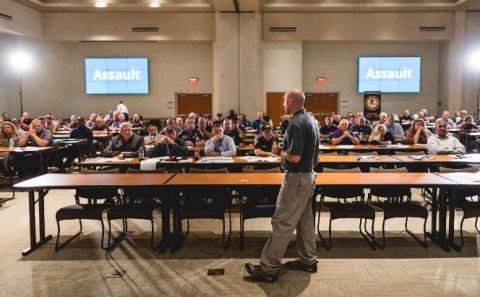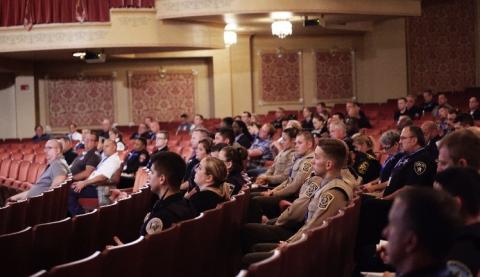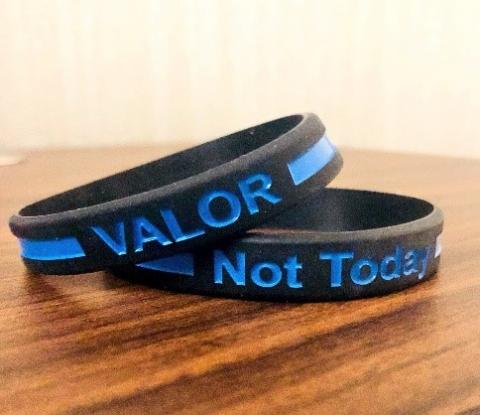More than 6,000 law enforcement agencies and 51,000 officers across all 50 states have participated in VALOR programming since 2010.
At an October homecoming parade in Jackson, Tennessee, Police Investigator Kelly Schrotberger took notice of a 15-year-old boy in the crowd. After watching him for some time, Schrotberger and a colleague came to believe the boy was acting in a manner that signaled he may be carrying a gun.
Just a few weeks prior, Schrotberger had attended a VALOR Officer Safety and Wellness Program Training that included a session on how people may act when they carry a weapon. Even if a person doesn't realize it, their body language and reaction to law enforcement are clues that they may be carrying a gun.
With the lessons from this course fresh on his mind, Schrotberger and a colleague approached the young man and had their suspicions confirmed. The boy, who turned out to be a gang member, was carrying a handgun in his front sweatshirt pocket. His intentions at the parade were unclear, but Schrotberger disarmed him without issue, preventing any trouble.
"This was a prime example of how he reacted and what he was doing as we watched and observed him," Schrotberger said of the event.
The VALOR Program, an initiative supported by the Bureau of Justice Assistance (BJA), provides training and technical assistance at no cost to state, local, and tribal law enforcement agencies upon request. VALOR trainings, such as the one Schrotberger attended, cover topics that support officers' physical and mental well-being. These courses remind officers to be vigilant in the line of duty and encourage them not to become complacent, which could jeopardize not only their own safety, but the safety of the communities they serve.
Since its inception in 2010, more than 6,000 law enforcement agencies and more than 51,000 officers across all 50 states have participated in VALOR programming.
Bringing VALOR to West Tennessee
In September 2018, Schrotberger was one of about 25 officers from the Jackson Police Department who attended the two-day VALOR training program that came to West Tennessee through the National Public Safety Partnership (PSP), also supported by BJA. After Jackson was named a PSP site in 2017, Captain Phillip Kemper suggested a VALOR training be brought to the area. He had already attended two VALOR sessions himself and was sold on the value of the program.
"For people that stay in this career for a long period of time, that's something that our profession has traditionally kind of left to the side. We don't put as much emphasis on mental resiliency and well-being,” he said. “It makes for a really great training program."
VALOR's core curriculum focuses on four primary challenges to officer wellness: suicide prevention, vehicle-related injuries and death, assaults against officers, and job-related stress.
Annually, the VALOR Program holds 10 to 12 events per month, with each designed for a specific target audience, said Patty Dobbs Hodges, VALOR Program Director with the Institute for Intergovernmental Research (IIR), the agency which carries out VALOR trainings under BJA's guidance.
The sessions are geared toward a variety of audiences, including line-level officers, mid-level leadership, and executive leadership. In 2017 and 2018, VALOR held more than 150 events and trained over 11,000 officers each year. Dobbs Hodges expects that VALOR will once again hold about 150 events and reach more than 10,000 officers in 2019.
Dangers of working in law enforcement
Danger and threats of physical harm are intrinsic to law enforcement. Every day presents officers with new and unpredictable challenges that can be stressful and both mentally and physically demanding.
In 2017, 93 law enforcement officers were killed in the line of duty either in accidents or felonious incidents, according to the FBI's Law Enforcement Officers Killed and Assaulted (LEOKA) Program. Further, law enforcement agencies reported that 60,211 officers were assaulted while performing their duties that year.
Dealing with difficult and often dangerous people on a daily basis, working long hours and overnight, and other work-related stresses take a toll on law enforcement officers. Obesity, heart attacks, substance abuse, and even suicide, are common results.
"Cops don’t talk to nobody, you just go and do your job," Schrotberger said. "You get used to chasing bad guys and seeing bad stuff every day for a career."
Yet, mental and physical health is critical to officers’ on-the-job performance and the collective safety of law enforcement and the communities they serve. Officers who are mentally and physically healthy not only respond better to emergencies and other challenging situations, but relate better to the people with whom they interact. In the long run it can create safer officers and safer communities.
One of the primary goals of the VALOR Program is to empower officers to overcome complacency. After years on the job, an officer may not be prepared for all of the dangers they face on a daily basis, possibly because there's no motivation to focus on preparation until, unfortunately, something happens.
"We don’t want people to have that attitude. We want people to be proactive in their own safety," Dobbs Hodges said.
Ongoing VALOR Training
The VALOR Program seeks to build long-standing relationships with officers and their agencies. In addition to individual follow-ups after a session, all VALOR training classes end with the Not Today Challenge.
For Kemper, officer complacency is something that he is well aware of —it's one of the reasons he uses the VALOR App on his cellphone daily.
Launched in 2015, the VALOR Officer Safety App started as just a basic checklist for officers to think about their safety before beginning their shifts. But recent updates have transformed the app to a platform supporting video trainings, podcasts, and blogs among other resources.
The app has been downloaded more than 6,800 times, said Dobbs Hodges. Moving forward, the plan is to add more micro-learning opportunities to it, such as short online trainings.
In Jackson, Kemper said one of his goals is to have the VALOR app installed on cellphones for each of the department's 228 officers.
"After you take the training, a week, month, or two months down the road, that's where complacency starts to set in,” he said. “Those reminders on my cell phone bring all of that training right back."
Are you a recipient of BJA funding? If so, let us know how the funds have impacted your community and efforts.




